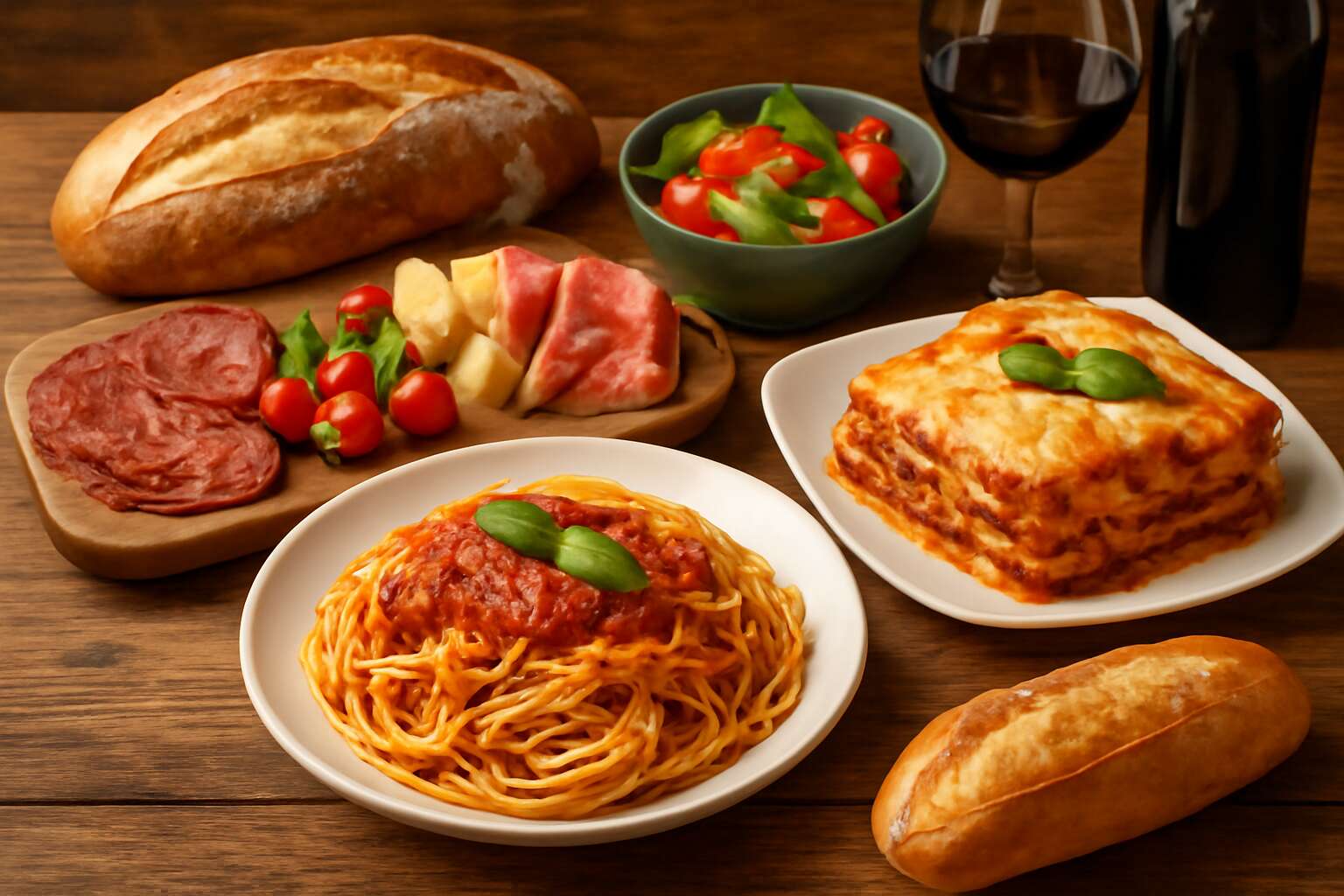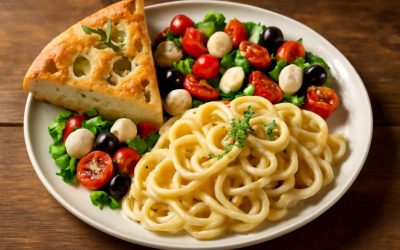Understanding Traditional Italian Food Names and Their Significance
Historical Origins of Italian Food Names – Exploring the roots of Italian culinary terminology
Few culinary traditions evoke the rich tapestry of history and culture quite like Italian cuisine. When pondering what are Italian food names, it becomes clear that each term carries a story, a cultural nuance, and often a geographical hint. These names are more than mere labels; they are windows into Italy’s past, reflecting centuries of regional influences, social customs, and evolving tastes.
Understanding the origins of Italian food names offers a fascinating glimpse into Italy’s historical roots. Many names date back to ancient times, rooted in Latin or regional dialects, often describing the dish’s ingredients, preparation method, or place of origin. For example, dishes like Risotto alla Milanese draw their name from Milan, anchoring the dish in its geographic homeland. This tradition of naming not only celebrates regional pride but also preserves a culinary legacy that continues to thrive today.
Regional Influences on Food Naming Conventions – How geographic and cultural diversity shapes dish names
Understanding traditional Italian food names is like unraveling a delicate tapestry woven from centuries of cultural history. Each dish’s name isn’t simply a label—it’s a story, a snapshot of Italy’s rich regional diversity and culinary evolution. When exploring what are Italian food names, it becomes evident that they often reflect the geographical roots and local customs that shape Italy’s vibrant food landscape.
Regional influences play a pivotal role in how dishes are named. Italy’s varied terrain—from the lush plains of Lombardy to the sun-drenched coasts of Sicily—imbues each cuisine with distinct characteristics. For example, the name “Spaghetti Carbonara” hints at Roman traditions, while “Risotto alla Milanese” proudly bears the mark of Milan’s influence. These names serve as cultural signposts, guiding us through Italy’s diverse culinary tapestry.
- Regional dialects
- Historical trade routes
- Local ingredients
all contribute to the naming conventions, creating a mosaic of flavors and stories that make Italian cuisine so unique and beloved worldwide.
Linguistic Aspects of Italian Food Names – The role of Italian language and dialects in naming dishes
Understanding what are Italian food names goes beyond simple labels on a menu; it’s a journey into centuries of cultural storytelling. Italian dishes are often named after their ingredients, preparation methods, or the regions they originate from, making each name a small window into Italy’s rich culinary history. The linguistic nuances embedded in these names reveal a tapestry of dialects, local expressions, and traditional terminology that have been passed down through generations.
Italian language and dialects play a crucial role in shaping what are Italian food names. For example, the term “Orecchiette” translates to “little ears,” describing the distinctive shape of this pasta from Puglia. These names not only describe the dish but also evoke a sense of place and tradition, anchoring each recipe in its regional roots. In many cases, dialects influence pronunciation and spelling, creating a diverse mosaic of culinary vocabulary across Italy.
Some dishes even carry poetic or descriptive names that reflect their sensory qualities or cultural significance. For instance, “Risotto alla Milanese” hints at the vibrant saffron-infused rice that is emblematic of Milan’s culinary identity. Such names often include specific ingredients, which serve as clues to their origins and flavor profiles. When exploring what are Italian food names, it’s fascinating to see how language acts as a bridge between the history, geography, and cultural fabric of Italy.
Common Italian Food Terms and Their Meanings
Popular Italian Dish Names – Examples like Pizza, Risotto, Lasagna, and their origins
Many people marvel at the rich tapestry of Italian cuisine, but few ponder the meaning behind the names of its most iconic dishes. When asking what are Italian food names, one uncovers a world woven with history, regional dialects, and culinary artistry. Take, for instance, the beloved pizza—an emblem of simplicity and innovation. Its name, originating from the Latin word ‘pinsa,’ evokes a sense of ancient tradition, yet its worldwide reputation is firmly rooted in Naples’ vibrant streets.
Similarly, risotto reveals its origins in Northern Italy, where the word ‘risotto’ stems from the Latin ‘risus,’ meaning ‘laughter,’ hinting at the joy this dish brings to the table. Lasagna, with its layered richness, derives from the Greek ‘lasanon,’ a term that traveled through time and language to find a home in Italian kitchens. These names are more than labels—they are stories, each whispering of regional influences and centuries of culinary evolution.
Understanding what are Italian food names allows us to appreciate not just the flavors but the deep cultural narratives woven into every bite.
Ingredients-Based Names – Names derived from key ingredients, e.g., Prosciutto, Mozzarella
When exploring the captivating world of Italian cuisine, understanding what are Italian food names is essential to truly appreciating its depth and richness. Many dishes derive their names directly from their ingredients, offering a deliciously transparent glimpse into their composition. For example, Prosciutto, the renowned cured ham, simply bears the name of its primary ingredient—prosciutto—highlighting its central role in Italian culinary traditions. Similarly, Mozzarella, the iconic soft cheese, takes its name from the Italian verb “mozzare,” meaning “to cut,” referencing the cheese-making process itself.
Ingredient-based names like these are more than labels; they serve as culinary signatures that evoke sensory experiences even before the first bite. They also reflect Italy’s regional diversity, where local ingredients often define both the dish and its name. This natural naming convention makes it easier for food lovers to identify what are Italian food names and their core components, fostering a deeper connection to Italy’s gastronomic heritage. Whether it’s a simple slice of Prosciutto or a ball of fresh Mozzarella, these names tell stories of tradition, craftsmanship, and regional pride woven into every dish.
Preparation Method Names – How cooking styles influence dish names, e.g., Gratin, Fritto
Italian cuisine is renowned worldwide not only for its rich flavors but also for its evocative names that often hint at the preparation method. When exploring what are Italian food names, understanding how cooking styles influence dish names adds a layer of cultural depth. For instance, “Fritto,” derived from the Italian verb “friggere” meaning “to fry,” designates dishes prepared through deep frying, like “Fritto Misto.” Similarly, “Gratin,” borrowed from French but widely used in Italy, describes a dish topped with breadcrumbs or cheese and baked to perfection. These preparation method names serve as culinary signposts, guiding diners through authentic Italian flavors. They evoke sensory memories even before tasting, revealing the artistry behind each dish’s creation. By recognizing these terms, food lovers can better appreciate the craftsmanship woven into Italy’s gastronomic tradition, making the exploration of what are Italian food names an engaging and enlightening journey.
Regional Italian Food Names and Unique Dishes
Northern Italy Specialties – Names like Polenta, Bagoss, and their cultural significance
Italy’s culinary landscape is a tapestry woven with regional identities, and understanding what are italian food names reveals much about Italy’s rich cultural diversity. In Northern Italy, dishes like Polenta and Bagoss are more than just ingredients—they embody centuries of tradition. Polenta, a staple made from cornmeal, symbolizes the rustic charm of regions like Lombardy and Veneto. Bagoss, a hard cheese from Lombardy, carries local pride and craftsmanship in every bite.
These names often reflect the cultural significance and geographic origins of the dishes. For example, Polenta’s prominence stems from the agrarian communities that relied on it as a primary carbohydrate source. Similarly, Bagoss’s unique aging process connects it deeply to local cheesemaking traditions. Exploring what are italian food names offers a window into Italy’s regional distinctions and culinary heritage, making each dish a story in itself.
Central Italy Classics – Dishes like Saltimbocca, Bucatini, and their regional roots
Regional Italian food names carry stories that echo through centuries of tradition and cultural evolution. In Central Italy, dishes like Saltimbocca and Bucatini are more than mere ingredients—they are symbols of local history and culinary craftsmanship. Saltimbocca, with its delicate layering of veal, prosciutto, and sage, originates from Rome’s vibrant streets, embodying spontaneity and sophistication. Bucatini, a thick, hollow pasta, roots itself in the heart of Lazio, capturing the rustic yet refined essence of the region’s cuisine.
Understanding what are Italian food names reveals a fascinating tapestry woven from local dialects, ingredient prominence, and culinary techniques. These names often hint at the dish’s preparation or regional origin, adding a layer of storytelling that elevates each bite. For example, the prominence of pasta varieties like Bucatini or regional specialties such as Saltimbocca highlights Italy’s diverse gastronomic landscape, where every name offers a glimpse into a place’s soul.
Southern Italy Traditional Names – Including Pizza Napoletana, Orecchiette, and more
In the vibrant tapestry of Italy’s culinary landscape, regional Italian food names serve as more than mere labels—they are stories etched into every dish, whispering secrets of centuries gone by. Southern Italy, with its fiery passion and rich history, boasts unique names that evoke the soul of its traditions. Take Pizza Napoletana, a masterpiece born from Naples’ volcanic soil, where each bite echoes the city’s resilient spirit and fiery ovens. Orecchiette, meaning “little ears,” is a pasta shape that captures the playful essence of Puglia’s coastal charm. These names are not arbitrary; they are poetic clues revealing the ingredients, techniques, or regional origins that make each dish special.
The enchanting world of what are italian food names reveals a kaleidoscope of flavors and stories. In Southern Italy, dishes often carry names rooted in local dialects, reflecting the passionate, improvisational nature of the region’s cuisine. From the rustic charm of street food to refined culinary masterpieces, understanding what are italian food names unlocks a deeper appreciation for the cultural mosaic that defines Italy’s gastronomy. It’s as if each dish carries a secret language, waiting to be understood and savored.
Italian Food Name Syntax and Naming Patterns
Use of Descriptive Terms in Food Names – Understanding adjectives, regional references, and culinary descriptors
Italian cuisine, with its poetic tapestry of flavors and history, beckons us to explore the intricate language behind each dish. When asking, what are Italian food names, one embarks on a journey where words are not mere labels but lyrical expressions woven with regional soul and culinary artistry. The syntax of these names often dances between descriptive adjectives, regional references, and culinary descriptors, creating a linguistic mosaic that captures the essence of Italy’s diverse gastronomy.
For instance, a dish like “Risotto alla Milanese” reveals more than just its ingredients; it whispers tales of regional pride and culinary tradition. Descriptive terms such as “fritto,” indicating frying, or “gratin,” hint at preparation methods that elevate simple ingredients into art. Understanding these naming patterns unlocks the cultural richness embedded in each title, making the question what are Italian food names an invitation to delve deeper into Italy’s gastronomic lexicon.
In essence, the use of regional references and culinary descriptors in Italian food names transforms everyday dishes into poetic expressions of Italy’s culinary landscape. Whether it’s “Orecchiette pugliese” echoing Puglia’s unique pasta shape or “Saltimbocca alla Romana” capturing Roman elegance, each name is a story waiting to be savored. This vibrant language not only informs but also ignites the imagination, offering a glimpse into Italy’s culinary soul.
Naming Trends in Contemporary Italian Cuisine – Modern influences and fusion naming styles
In the ever-evolving landscape of Italian cuisine, the question of what are Italian food names reveals a captivating blend of tradition, creativity, and modern innovation. Contemporary Italian chefs are increasingly experimenting with fusion naming styles, seamlessly blending old-world charm with forward-thinking culinary trends. This evolution manifests in playful yet meaningful titles that reflect not just ingredients but also cultural influences and global palate preferences.
Modern influences often see Italian dishes adopting hybrid nomenclature, where the classic meets the contemporary. For example, a dish like “Sushi alla Siciliana” cleverly marries Japanese technique with Sicilian flavors, challenging traditional boundaries. Such names serve as linguistic bridges, inviting diners into a culinary dialogue that respects history while embracing innovation. Often, these naming patterns include descriptive terms that highlight preparation methods or regional twists, making each dish a story in itself.
Interestingly, some trends lean toward simplified or even whimsical names, especially in upscale fusion restaurants. Yet, even in these playful contexts, the core question remains: what are Italian food names? They are increasingly becoming a canvas for chefs to showcase their artistry—merging regional authenticity with global inspiration. This style of naming not only sparks curiosity but also reflects Italy’s dynamic gastronomic identity in a global culinary scene.
How Italian Food Names Influence Cultural Identity and Cuisine Recognition
The Role of Food Names in Italian Heritage – Preserving tradition through dish naming
Italian food names are more than mere labels; they are living symbols of a nation’s soul, echoing centuries of tradition, regional pride, and culinary artistry. When we ask, what are Italian food names, we uncover a tapestry woven with history, dialect, and cultural nuance. These names serve as a bridge, connecting modern diners to Italy’s rich heritage, where each dish narrates a story rooted in its geographic origin and local customs.
Food naming in Italy functions as a cultural lexicon—an intricate language that preserves tradition and amplifies regional identity. For instance, dishes like Orecchiette from Puglia or Risotto from Lombardy are more than ingredients; they are emblematic of their communities’ identities. This cultural significance ensures that, when people inquire about what are Italian food names, they gain insight into a vibrant mosaic of culinary history. These names not only recognize the artistry behind each dish but also elevate them to symbols of Italy’s enduring heritage.
Global Popularity and Americanization of Italian Food Names – Adapting names for international markets
Italian food names are more than just labels on a menu; they serve as cultural signifiers that influence both national identity and global recognition of Italian cuisine. When we ask, what are Italian food names, we uncover a complex tapestry woven from regional dialects, historical influences, and culinary traditions that have traveled across borders. These names foster a sense of pride and authenticity, shaping how Italians see their culinary heritage and how the world perceives their gastronomic artistry.
As Italian dishes gained worldwide popularity, many traditional names have been adapted for international markets, sometimes losing their original nuance but gaining broader appeal. For example, the classic pizza has become a universal symbol of Italy, yet its name varies in different countries—sometimes simplified, sometimes infused with local flavor. This adaptation often reflects the *Americanization of Italian food names*, which can both help and hinder the preservation of authentic culinary identity. Still, these names act as cultural ambassadors, sparking curiosity about Italy’s diverse regional cuisines and inspiring culinary exploration.
Moreover, the global popularity of Italian food names contributes significantly to the recognition of Italian cuisine as a whole. Dishes like Risotto, Lasagna, and Polenta are now household words, transcending their origins to become international staples. This widespread familiarity fosters a shared culinary language, yet it also raises questions about the preservation of regional authenticity amidst the influence of international markets. While some purists advocate for maintaining traditional names and recipes, others embrace fusion and reimagining, showcasing the dynamic nature of Italian food naming trends.
Authenticity and Branding of Italian Food Names – Ensuring genuine representation in global cuisine
In the intricate tapestry of global gastronomy, the question of what are Italian food names extends beyond mere labels on a menu; these names are living artifacts of Italy’s rich cultural mosaic. They serve as potent symbols of regional identity, echoing centuries of culinary tradition and regional dialects that have shaped Italy’s diverse gastronomic landscape. Each dish name encapsulates a story—be it the rustic charm of Southern Italy’s pizza Napoletana or the refined elegance of Central Italy’s Saltimbocca—creating a shared language that resonates across borders.
Furthermore, the recognition and branding of Italian cuisine hinge on these evocative names. Authenticity is often rooted in the preservation of original terminology, which fosters a genuine connection to Italy’s culinary heritage. Yet, as Italian food names become global commodities, adaptation and Americanization sometimes dilute their original nuance. Still, these names function as powerful cultural ambassadors, igniting curiosity and culinary exploration worldwide. The ongoing dialogue between tradition and innovation—embedded deeply within the what are italian food names—continues to define the dynamic evolution of Italy’s iconic dishes on the global stage.




0 Comments